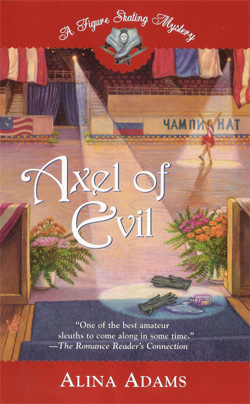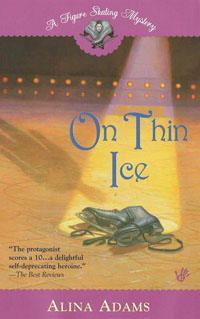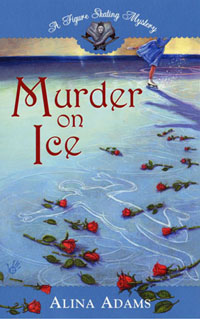LIGHTS, CAMERA, AXEL (PART #8)
Eager to top even the figure-skating frenzy of 1994, American coverage of the 1998 Winter Olympics in Nagano, Japan didn't limit itself merely to CBS-TV's televising the competition cushioned by tear-jerking and/or uplifting personality features on either side.
TNT also got into the act, trying to hook the soap-opera and talk-show audience with a daily, afternoon talk-show of their own, "The Cutting Edge," devoted exclusively to figure skating. 1984 Olympic Silver Medalists Peter Carruthers and Rosalynn Sumners, along with 1976 Olympian Alice Cook, hosted from a set erected in the corner of the practice rink, where any spill a skater took in practice could now be instantly pointed out and dissected. Since CBS held first broadcast rights to the actual competition, "The Cutting Edge" made due with rink-note gossip, predictions, speculations, and playing 'fashion-police' for some of the more atrocious costume choices. (At dinner the previous night, I described one skater's costume -- it may have been Austria's Julia Lautowa; but the mind grows fuzzy -- as looking like "she escaped from a bordello after being mauled by a lion." The next night, Roz repeated my comment on the air. Gulp. It was my "Broadcast News" moment. "I say it here, it comes out there...")
Along with those two American networks, and a host of local TV and radio stations, the athletes found themselves being covered and commented on by announcers from Canada, France, Germany, Australia, Russia, Great Britain, Poland, Ukraine, China, and both NHK and TBS of Japan. Many broadcast teams were anchored by former competitive skaters, several of whom also worked as choreographers or coaches for the same skaters they were commenting on.
1984 World Pair Champion Paul Martini, as analyst for Canada's CBC, was forbidden from even giving the appearance of coaching his team, 1997 Canadian Champions Marie-Claude Savard-Gagnon and Luc Bradet. As a result, he had to sit by helplessly and just watch as, during the Long Program, both his flu-stricken skaters nearly came apart at the seams. Dizzy and sick, they needed to stop skating in the middle of their routine to shakily compose themselves.
Sitting by Paul in the CBC booth was five-time Canadian Pair Champion Sandra Bezic. In 1988, she choreographed Brian Boitano's Olympic Gold medal performance to Napoleon. But, back then, she'd only been a spectator, visibly jumping up and down and applauding in the background as Brian completed his routine. Ten years later, as two of her newest protegees, America's Tara Lipinski and China's Lu Chen, skated to Gold and Bronze, respectively, Sandra was faced with presenting commentary on programs of her own design.
Robin Cousins, 1980 Olympic champion and choreographer for the 1998 U.S. Bronze Medalist Nicole Bobek, was in the same boat, working for the BBC. Although, by the time Nicole finished stumbling and tripping through Short and Long programs that mired her in a record-low 17th place, Robin was asserting that barely three steps of his original work had made it to the competition.
1984 US Pair Silver Medalist Lea Ann Miller had things a little easier. As Associate Producer for CBS-TV, she, at least, did not have to be on-camera, feigning objectivity, while her student, Japan's own teen sensation Takeshi Honda, skated his programs. Lea Ann was free to take off her head-seat, and nervously burrow her fingers into the arm of CBS analyst, 1988 Olympic Bronze Dance Medalist Tracy Wilson.
With the world watching every move they made, the skaters in Nagano couldn't help but start playing to the cameras. And battling for placings not only on the ice, but among the press, as well...
(To Be Continued)
TNT also got into the act, trying to hook the soap-opera and talk-show audience with a daily, afternoon talk-show of their own, "The Cutting Edge," devoted exclusively to figure skating. 1984 Olympic Silver Medalists Peter Carruthers and Rosalynn Sumners, along with 1976 Olympian Alice Cook, hosted from a set erected in the corner of the practice rink, where any spill a skater took in practice could now be instantly pointed out and dissected. Since CBS held first broadcast rights to the actual competition, "The Cutting Edge" made due with rink-note gossip, predictions, speculations, and playing 'fashion-police' for some of the more atrocious costume choices. (At dinner the previous night, I described one skater's costume -- it may have been Austria's Julia Lautowa; but the mind grows fuzzy -- as looking like "she escaped from a bordello after being mauled by a lion." The next night, Roz repeated my comment on the air. Gulp. It was my "Broadcast News" moment. "I say it here, it comes out there...")
Along with those two American networks, and a host of local TV and radio stations, the athletes found themselves being covered and commented on by announcers from Canada, France, Germany, Australia, Russia, Great Britain, Poland, Ukraine, China, and both NHK and TBS of Japan. Many broadcast teams were anchored by former competitive skaters, several of whom also worked as choreographers or coaches for the same skaters they were commenting on.
1984 World Pair Champion Paul Martini, as analyst for Canada's CBC, was forbidden from even giving the appearance of coaching his team, 1997 Canadian Champions Marie-Claude Savard-Gagnon and Luc Bradet. As a result, he had to sit by helplessly and just watch as, during the Long Program, both his flu-stricken skaters nearly came apart at the seams. Dizzy and sick, they needed to stop skating in the middle of their routine to shakily compose themselves.
Sitting by Paul in the CBC booth was five-time Canadian Pair Champion Sandra Bezic. In 1988, she choreographed Brian Boitano's Olympic Gold medal performance to Napoleon. But, back then, she'd only been a spectator, visibly jumping up and down and applauding in the background as Brian completed his routine. Ten years later, as two of her newest protegees, America's Tara Lipinski and China's Lu Chen, skated to Gold and Bronze, respectively, Sandra was faced with presenting commentary on programs of her own design.
Robin Cousins, 1980 Olympic champion and choreographer for the 1998 U.S. Bronze Medalist Nicole Bobek, was in the same boat, working for the BBC. Although, by the time Nicole finished stumbling and tripping through Short and Long programs that mired her in a record-low 17th place, Robin was asserting that barely three steps of his original work had made it to the competition.
1984 US Pair Silver Medalist Lea Ann Miller had things a little easier. As Associate Producer for CBS-TV, she, at least, did not have to be on-camera, feigning objectivity, while her student, Japan's own teen sensation Takeshi Honda, skated his programs. Lea Ann was free to take off her head-seat, and nervously burrow her fingers into the arm of CBS analyst, 1988 Olympic Bronze Dance Medalist Tracy Wilson.
With the world watching every move they made, the skaters in Nagano couldn't help but start playing to the cameras. And battling for placings not only on the ice, but among the press, as well...
(To Be Continued)






0 Comments:
Post a Comment
Links to this post:
Create a Link
<< Home